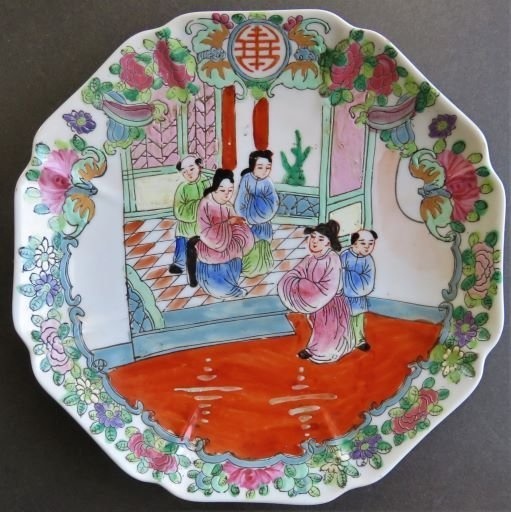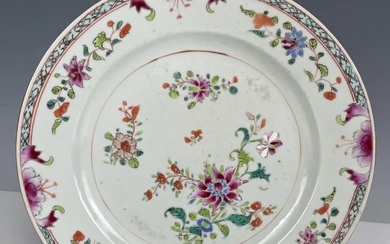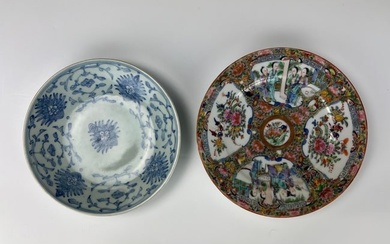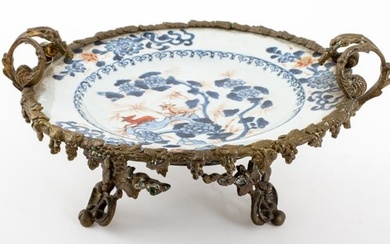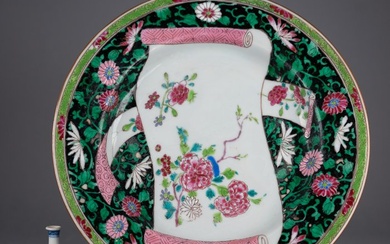Antique Chinese Porcelain Plate, Qianlong, 1739-1795, Famille Rose
Antique Chinese export porcelain plate, decorated in Famille Rose enamels with a scene from "The Romance of the West Chamber." Qianlong mark and period (1736-1795).
The figural composition shows a young scholar Zhang Sheng meeting Cui Yingying, the daughter of a chief minister of the Tang court. Cui Yingying stands next to her siting mother. There are two additional figures, boys, probably servants- one behind Zhang Sheng, and one behind Cui Yingying's mother.
Yingying and her mother have stopped in the Buddhist monastery to rest while escorting the coffin of Yingying's father to their native town. Zhang Sheng falls in love with her immediately, but is prevented from expressing his feelings while Yingying is under her mother's watchful eye.
The figural scene is enclosed by the floral borders: floral decor with large central blooms. The symbol for longevity on top of the composition is framed by two bats on the sides. Two other bats are on the sides at the large flowers. The wings of the bats are gilt. The word 'bat' in Chinese is similar to the word for happiness. Therefore, bat means good luck, a blessing. There are four bats on the plate: The four traditional blessings are happiness, professional success or prosperity, longevity and good fortune.
There is the archaic zhuanshu seal of the Emperor Qianlong is stamped in red-iron oxide on the back over-glaze. "On later Qianlong copies the seal mark in red enamel is something of a favorite."
Condition and Identification Points:
Thick and heavy porcelain plate, 8.3/4" [c.22cm] across, very good condition.
The imperfect, partially heavy glazes with a few small sand and colored glaze particles melted into them.
The colored glazes are consistent with the 18th Century Famille Rose palette.
Gilding: gold is dull; gold surface is rough like several other glazes. This gilding was done by the method developed during the Kangxi reign (1712-1722). Gold leaf was grind into a powder and mixed with colorless lead enamel. This gilding method was abounded during the 18th century, because of the poor quality of gilding [see photos].
The new gilding method, increasingly used in the 18th century was called "best gilding", "fire gilding". Pure gold was mixed with mercury to a liquid, applied to the piece to be gilded and than fired at about 730 centigrade to leave pure gold. The gold was dull when it came from the kiln and needed to be burnished to produce a bright finish. However, the gold surface created by such 'fire gilding' method was even and smooth.
The 'liquid gold' which results in smooth glossy gold surface came to China from Europe in the 1850s.
While imperfect dirty glazing similar to the 18th century, can be sometimes found on the porcelain of the Republic Period (1910s-1920s), the gilding was done either by 'fire gilding' or liquid gold methods. Gold powder mixed with glaze method was abandoned in the 18th century.
Guest & Gray, London:
"Chinese famille-rose porcelain refers to Chinese porcelain decorated with predominantly pink coloured enamel, made from colloidal gold, which was first used in the late Kangxi period. In early eighteenth century Chinese famille-rose was sometimes referred to as 'fencai' meaning foreign colour......
On famille-rose porcelain made at Jingdezhen - this factory was restarted in 1683 after its destruction during the Qing defeat of the Ming earlier in the century - the enamel was not initially as clean and translucent as it quickly became in the Yongzheng period, when it reached its qualitative peak. There are one or two dateable early Canton enamel pieces where the enamel is quite poor. The fine and delicate decoration with fine shading to the enamels on Yongzheng porcelain had a feminine quality, unlike the famille-verte porcelain made in the preceding period of Kangxi, when the decoration tended to be very much stronger. In the subsequent Qianlong period the quality on the export wares started to deteriorate quite rapidly. The enamels became far less clean and translucent and the drawing not so fine. In the Imperial porcelain the quality remained much higher.
In genuine pieces, the enamels are usually much thicker than that found on most copies. Another characteristic of copies is that their glaze is too clean and glassy and this can be best seen where it accumulates inside foot rims. Copies often got the potting wrong. During the Kangxi period the rims of bowls tended to be quite thin, whereas later on the rims were inclined to be thicker. The thickness and weight of the bases of 18th century bowls were nicely balanced to the rest of the dish or bowl, but in the 19th century most of the weight often resided in the base."
Rates vary per zone/ country, we will adjust shipping costs with the invoice.
US: Priority (c.2-4 days) ----------- $54.50
Canada: Express (c.4-8 days) ----- $95.50
World: Express (c.5-10 days) ---- $129.50
View it on
Estimate
Reserve
Time, Location
Auction House
Antique Chinese export porcelain plate, decorated in Famille Rose enamels with a scene from "The Romance of the West Chamber." Qianlong mark and period (1736-1795).
The figural composition shows a young scholar Zhang Sheng meeting Cui Yingying, the daughter of a chief minister of the Tang court. Cui Yingying stands next to her siting mother. There are two additional figures, boys, probably servants- one behind Zhang Sheng, and one behind Cui Yingying's mother.
Yingying and her mother have stopped in the Buddhist monastery to rest while escorting the coffin of Yingying's father to their native town. Zhang Sheng falls in love with her immediately, but is prevented from expressing his feelings while Yingying is under her mother's watchful eye.
The figural scene is enclosed by the floral borders: floral decor with large central blooms. The symbol for longevity on top of the composition is framed by two bats on the sides. Two other bats are on the sides at the large flowers. The wings of the bats are gilt. The word 'bat' in Chinese is similar to the word for happiness. Therefore, bat means good luck, a blessing. There are four bats on the plate: The four traditional blessings are happiness, professional success or prosperity, longevity and good fortune.
There is the archaic zhuanshu seal of the Emperor Qianlong is stamped in red-iron oxide on the back over-glaze. "On later Qianlong copies the seal mark in red enamel is something of a favorite."
Condition and Identification Points:
Thick and heavy porcelain plate, 8.3/4" [c.22cm] across, very good condition.
The imperfect, partially heavy glazes with a few small sand and colored glaze particles melted into them.
The colored glazes are consistent with the 18th Century Famille Rose palette.
Gilding: gold is dull; gold surface is rough like several other glazes. This gilding was done by the method developed during the Kangxi reign (1712-1722). Gold leaf was grind into a powder and mixed with colorless lead enamel. This gilding method was abounded during the 18th century, because of the poor quality of gilding [see photos].
The new gilding method, increasingly used in the 18th century was called "best gilding", "fire gilding". Pure gold was mixed with mercury to a liquid, applied to the piece to be gilded and than fired at about 730 centigrade to leave pure gold. The gold was dull when it came from the kiln and needed to be burnished to produce a bright finish. However, the gold surface created by such 'fire gilding' method was even and smooth.
The 'liquid gold' which results in smooth glossy gold surface came to China from Europe in the 1850s.
While imperfect dirty glazing similar to the 18th century, can be sometimes found on the porcelain of the Republic Period (1910s-1920s), the gilding was done either by 'fire gilding' or liquid gold methods. Gold powder mixed with glaze method was abandoned in the 18th century.
Guest & Gray, London:
"Chinese famille-rose porcelain refers to Chinese porcelain decorated with predominantly pink coloured enamel, made from colloidal gold, which was first used in the late Kangxi period. In early eighteenth century Chinese famille-rose was sometimes referred to as 'fencai' meaning foreign colour......
On famille-rose porcelain made at Jingdezhen - this factory was restarted in 1683 after its destruction during the Qing defeat of the Ming earlier in the century - the enamel was not initially as clean and translucent as it quickly became in the Yongzheng period, when it reached its qualitative peak. There are one or two dateable early Canton enamel pieces where the enamel is quite poor. The fine and delicate decoration with fine shading to the enamels on Yongzheng porcelain had a feminine quality, unlike the famille-verte porcelain made in the preceding period of Kangxi, when the decoration tended to be very much stronger. In the subsequent Qianlong period the quality on the export wares started to deteriorate quite rapidly. The enamels became far less clean and translucent and the drawing not so fine. In the Imperial porcelain the quality remained much higher.
In genuine pieces, the enamels are usually much thicker than that found on most copies. Another characteristic of copies is that their glaze is too clean and glassy and this can be best seen where it accumulates inside foot rims. Copies often got the potting wrong. During the Kangxi period the rims of bowls tended to be quite thin, whereas later on the rims were inclined to be thicker. The thickness and weight of the bases of 18th century bowls were nicely balanced to the rest of the dish or bowl, but in the 19th century most of the weight often resided in the base."
Rates vary per zone/ country, we will adjust shipping costs with the invoice.
US: Priority (c.2-4 days) ----------- $54.50
Canada: Express (c.4-8 days) ----- $95.50
World: Express (c.5-10 days) ---- $129.50
